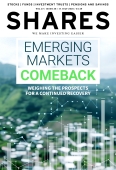Archived article
Please note that tax, investment, pension and ISA rules can change and the information and any views contained in this article may now be inaccurate.
When should you give an underperforming fund manager the boot?

In his latest semi-annual letter to shareholders, Terry Smith has laid out another spell of underperformance for the Fundsmith Equity (B41YBW7) fund. The fund fell behind the MSCI World Index by a modest amount, just 2% in the first six months of this year. However, this comes on the back of four calendar years of failing to beat the global stock market.
Investors in Fundsmith Equity will no doubt draw their own conclusions. But this does tap into the wider question of how long you should give a fund manager who is underperforming. Professional investors, like those who put together the AJ Bell Favourite Funds list, will interrogate managers face to face, and analyse their funds in detail, finding out the precise reasons for underperformance, and looking for signs the manager isn’t sticking to their knitting.
Replicating this approach is challenging for the everyday investor, who doesn’t usually have the time or resources to dedicate themselves to analysing funds in such forensic detail. That’s why professionally selected funds lists, like AJ Bell’s Favourite Funds, can be a helpful resource for investors to check on. But when a fund manager goes through a difficult patch, there are also questions DIY investors can ponder which will help them come to a decision on whether to stick or twist.
MEASURING PERFORMANCE
The first thing to do is assess performance properly. Fund price movements up and down are clearly what ultimately matter most to investors, but if you’re evaluating an active manager, you need to compare performance to an appropriate benchmark. Often this will be shown on the fund’s factsheet, but do be a bit careful as sometimes fund groups provide performance compared to the fund sector they sit in. This might not be a bad comparator, depending on the sector, but it probably won’t be as good as the official benchmark, which will normally at least be stated on the factsheet. When looking at investment trusts, it’s the NAV (net asset value) return which you should focus on, if you’re assessing a manager’s performance. The share price return includes movements in the discount and premium, which the fund manager can’t realistically be expected to control.
All active managers will go through periods of underperformance, so you shouldn’t worry too much about a short spell when the fund falls behind its benchmark. As well as total performance over a given time period, consider annual performance over the last five years too, which is normally presented on the fund factsheet. Consider if there was one bad year which has been responsible for most of the underperformance, and how the fund has done otherwise.
ALL LONG PERIODS OF POOR RETURNS START WITH A SHORT ONE
All long periods of underperformance start with a short one, and deciding if and when to pull the plug is undoubtedly a difficult one. As a fund investor, you have a choice about how to go about things. Either you cut and run at the first sign of trouble, or you sit and wait it out. If you jump ship quickly, you might get out of some funds before a long downturn in performance, but equally you will miss some that bounce back. Meanwhile you also rack up trading costs and spend a lot of time and effort moving your portfolio around. You also have to switch your money into another fund, and who’s to say the one you choose is not about to embark a period of underperformance? If you choose the patient route, you avoid these issues. Sometimes you will hold a fund for longer than you would with perfect hindsight, but in a diversified portfolio, other funds should take up the slack.
CONSIDER THE MARKET CONTEXT
It’s also important to consider what’s going on in the market and whether that explains underperformance. Fund managers tend to have a certain style, which is to say there are certain types of stocks, sectors or segments of the market which their investment strategy leads them towards. These could be dividend payers, smaller companies, or growth stocks, for instance. Such styles can fall out of favour and remain unloved for long periods, which means some forbearance is required if this is the root of fund underperformance.
Right now, many fund managers investing globally or in the US have found it hard to match the world index, which has been driven higher by a small clutch of big technology companies. If an active manager didn’t hold these stocks, or simply held less than the index, it would have left the rest of the portfolio needing to do a lot of heavy lifting to generate outperformance. The hegemony of the Magnificent Seven has moderated somewhat in 2025, but even if that trend is sustained, it will take some time to feed through into long-term performance figures.
ONE IN, ONE OUT
If you sell out of a fund because of under-performance, you’ll need to put your money somewhere else. There are broadly two options if you’re staying invested. One is to go for a tracker fund, which can be expected to underperform the index by a small amount (the annual fund charges) each year. This is a wholesale change in approach and implies some disillusionment with active management as a whole.
The other option is to pick another active fund manager, though of course this means you still have the possibility of experiencing underperformance. There’s a real risk here that if you keep moving out of underperforming funds and into top performers, you’re selling low and buying high, which can have a damaging effect on your wealth over the long term. The other risk is that you pull out of an active fund without any idea where to put the proceeds, and you end up just sitting in cash. It’s easy to forget to reinvest that money, which potentially means missing out on returns as the market rises.
DISCLAIMER: AJ Bell owns Shares Magazine. The author (Laith Khalaf) and editor (Tom Sieber) of this article own shares in AJ Bell.
Important information:
These articles are provided by Shares magazine which is published by AJ Bell Media, a part of AJ Bell. Shares is not written by AJ Bell.
Shares is provided for your general information and use and is not a personal recommendation to invest. It is not intended to be relied upon by you in making or not making any investment decisions. The investments referred to in these articles will not be suitable for all investors. If in doubt please seek appropriate independent financial advice.
Investors acting on the information in these articles do so at their own risk and AJ Bell Media and its staff do not accept liability for losses suffered by investors as a result of their investment decisions.
Issue contents
Feature
Great Ideas
News
- Infrastructure group Galliford Try hits five-year high on raised guidance
- ‘Ugly’ update sends former ad giant WPP’s stock to 15-year low
- New tariffs threaten European, Canadian and Mexican trade with the US
- Lockheed Martin’s Q2 clues to US defence spending regime
- Bitcoin prices set record as investor bet big on ‘crypto week’
 magazine
magazine








